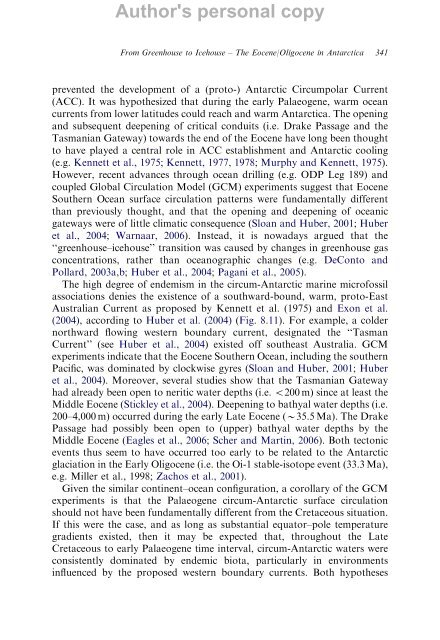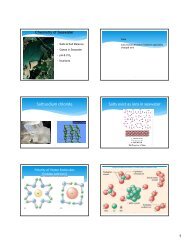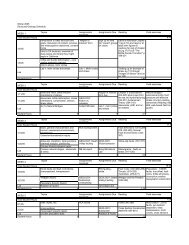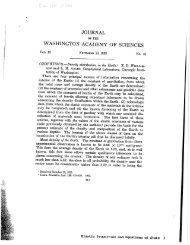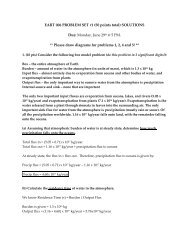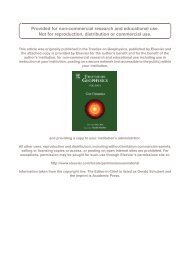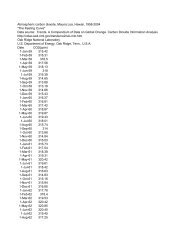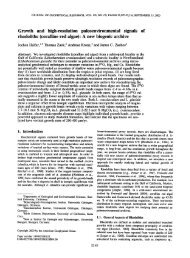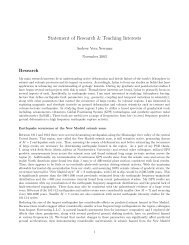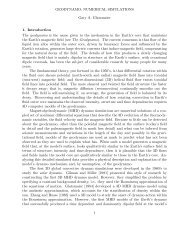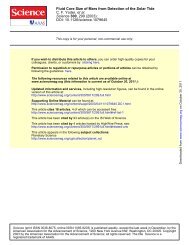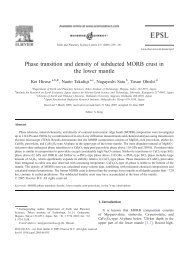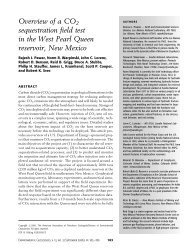From Greenhouse to Icehouse – The Eocene/Oligocene - UMass ...
From Greenhouse to Icehouse – The Eocene/Oligocene - UMass ...
From Greenhouse to Icehouse – The Eocene/Oligocene - UMass ...
Create successful ePaper yourself
Turn your PDF publications into a flip-book with our unique Google optimized e-Paper software.
Author's personal copy<br />
<strong>From</strong> <strong>Greenhouse</strong> <strong>to</strong> <strong>Icehouse</strong> <strong>–</strong> <strong>The</strong> <strong>Eocene</strong>/<strong>Oligocene</strong> in Antarctica 341<br />
prevented the development of a (pro<strong>to</strong>-) Antarctic Circumpolar Current<br />
(ACC). It was hypothesized that during the early Palaeogene, warm ocean<br />
currents from lower latitudes could reach and warm Antarctica. <strong>The</strong> opening<br />
and subsequent deepening of critical conduits (i.e. Drake Passage and the<br />
Tasmanian Gateway) <strong>to</strong>wards the end of the <strong>Eocene</strong> have long been thought<br />
<strong>to</strong> have played a central role in ACC establishment and Antarctic cooling<br />
(e.g. Kennett et al., 1975; Kennett, 1977, 1978; Murphy and Kennett, 1975).<br />
However, recent advances through ocean drilling (e.g. ODP Leg 189) and<br />
coupled Global Circulation Model (GCM) experiments suggest that <strong>Eocene</strong><br />
Southern Ocean surface circulation patterns were fundamentally different<br />
than previously thought, and that the opening and deepening of oceanic<br />
gateways were of little climatic consequence (Sloan and Huber, 2001; Huber<br />
et al., 2004; Warnaar, 2006). Instead, it is nowadays argued that the<br />
‘‘greenhouse<strong>–</strong>icehouse’’ transition was caused by changes in greenhouse gas<br />
concentrations, rather than oceanographic changes (e.g. DeCon<strong>to</strong> and<br />
Pollard, 2003a,b; Huber et al., 2004; Pagani et al., 2005).<br />
<strong>The</strong> high degree of endemism in the circum-Antarctic marine microfossil<br />
associations denies the existence of a southward-bound, warm, pro<strong>to</strong>-East<br />
Australian Current as proposed by Kennett et al. (1975) and Exon et al.<br />
(2004), according <strong>to</strong> Huber et al. (2004) (Fig. 8.11). For example, a colder<br />
northward flowing western boundary current, designated the ‘‘Tasman<br />
Current’’ (see Huber et al., 2004) existed off southeast Australia. GCM<br />
experiments indicate that the <strong>Eocene</strong> Southern Ocean, including the southern<br />
Pacific, was dominated by clockwise gyres (Sloan and Huber, 2001; Huber<br />
et al., 2004). Moreover, several studies show that the Tasmanian Gateway<br />
had already been open <strong>to</strong> neritic water depths (i.e. o200 m) since at least the<br />
Middle <strong>Eocene</strong> (Stickley et al., 2004). Deepening <strong>to</strong> bathyal water depths (i.e.<br />
200<strong>–</strong>4,000 m) occurred during the early Late <strong>Eocene</strong> (B35.5 Ma). <strong>The</strong> Drake<br />
Passage had possibly been open <strong>to</strong> (upper) bathyal water depths by the<br />
Middle <strong>Eocene</strong> (Eagles et al., 2006; Scher and Martin, 2006). Both tec<strong>to</strong>nic<br />
events thus seem <strong>to</strong> have occurred <strong>to</strong>o early <strong>to</strong> be related <strong>to</strong> the Antarctic<br />
glaciation in the Early <strong>Oligocene</strong> (i.e. the Oi-1 stable-iso<strong>to</strong>pe event (33.3 Ma),<br />
e.g. Miller et al., 1998; Zachos et al., 2001).<br />
Given the similar continent<strong>–</strong>ocean configuration, a corollary of the GCM<br />
experiments is that the Palaeogene circum-Antarctic surface circulation<br />
should not have been fundamentally different from the Cretaceous situation.<br />
If this were the case, and as long as substantial equa<strong>to</strong>r<strong>–</strong>pole temperature<br />
gradients existed, then it may be expected that, throughout the Late<br />
Cretaceous <strong>to</strong> early Palaeogene time interval, circum-Antarctic waters were<br />
consistently dominated by endemic biota, particularly in environments<br />
influenced by the proposed western boundary currents. Both hypotheses


